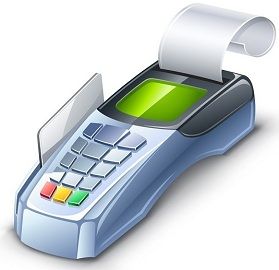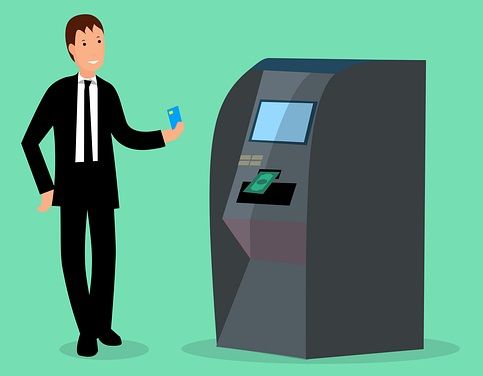 When you spend money using your credit card, this means that you are not using your own money, rather you are taking a short-term loan. Credit history, paying capacity, income, and debts are the parameters that are taken into consideration while determining the maximum amount of credit.
When you spend money using your credit card, this means that you are not using your own money, rather you are taking a short-term loan. Credit history, paying capacity, income, and debts are the parameters that are taken into consideration while determining the maximum amount of credit.
On the other hand, when you spend money using your debit card, it implies that you are spending the money you own, as it is directly linked to your current (checking) account or savings account, so once the money is spent on something, it’s gone. So, a debit card is just like a cheque which when used, money is subtracted from the personal savings/current account of the account holder.
Basically both debit card and credit card are plastic cards issued by a bank or financial institution which look exactly similar, bearing a 16 digit number, validity period, name of the cardholder, magnetic strip, EMV chip, and Visa or MasterCard logo.
What is Plastic Money?
An alternative of cash currency while making a purchase, with the use of a card made up of plastic, is called plastic money. So, we can say that plastic money is an alternative payment system.
In this writeup, we have discussed all the points of difference between debit card and credit card.
Content: Credit Card Vs Debit Card
- Comparison Chart
- Definition
- Key Differences
- Similarities
- Frequently Asked Questions (FAQs)
- Conclusion
Comparison Chart
| Basis for Comparison | Credit Card | Debit Card |
|---|---|---|
| Meaning | A Credit Card is a plastic card that allows the customer to purchase goods and services on credit, up to the specified limit. Here, the card issuer makes payment on the customer's behalf. | Debit Card is a plastic card, through which the customer can spend money by drawing funds that are deposited in his/her bank account. |
| Issued by | Banks and a few non-banks, and it can also be issued by various approved enterprises. | Banks and are linked to the bank account. |
| Payment terms | Deferred | Immediate debit to customer's account |
| Implies | Pay later | Pay now |
| Credit Period | Generally 45 days, and it is normally structured as revolving credit. | No credit, instant debit |
| Account with the issuing bank | Not necessary | Necessary, which is linked with the card |
| Access to deposit account | No access | Direct Access to the concerned account, be it current or savings account |
| Credit score | It helps in creating good credit and improve credit score | No impact on the credit score |
| Rewards | It offers rewards, on the basis of spending like cashback, vouchers, reward points, etc. which are redeemable. | No or Minimum rewards or incentives for spending. |
| Eligibility criteria | Specific eligibility criteria, which must be fulfilled | No eligibility criteria |
| Maximum Withdrawal Limit | Determined on the basis of credit score, existing debt, and credit history of the customer. | Less than the balance lying on the credit of your savings or current account, to which the card is linked. |
| Source of money | Credit extended by the card issuer | Concerned bank account |
| Spending | Spend more than what you have | Spend only what you have |
| Who pays for the purchase? | The credit card company pays to the vendor first on behalf of the card holder for the purchase and then the cardholder pays to the credit card company. | The account holder pays for the purchase. |
| Bill | You get a monthly credit statement or bill that reflects all the transactions that took place during the period. | You do not get any bill or statement at the end of the month. |
| Interest | Interest is charged on the outstanding balance when payment is not made to the bank within a specified time period. | No interest is charged. |
| Penalty for default | High | Not applicable |
Definition of Credit Card
A credit card is a card made up of plastic, that is why it is also called plastic money. It is basically a method of postponing payment, wherein the customer makes purchases and pays later on, to the bank or financial institution which makes payment on the customer’s behalf at the time of purchase.
- It provides its user instantaneous credit facility, which is usually between 30-45 days. It is structured like a revolving credit agreement.
- For the purpose of making transactions a four-digit PIN is assigned to the customer, so that every time the card is used, they need to authenticate the same with the PIN. This is just to add an extra layer of security.
- These are primarily used for making purchases of goods and services at Payment terminals or online purchases.
- They can be used both domestically or internationally subject to they are enabled for such use.
- On the basis of the financial standing and past financial history of the customer, the credit limit is given to the credit cardholder. It is maintained by the credit card department of the bank.
Credit cards are used by millions of people around the world, and they repay their dues at the end of each month without any fees or interest, while there are also a number of people who carry forward their balances month on month and pay interest on the money spent by them previously. Also, such people pay a definite sum to the concerned bank or financial institution for skipping the repayment in the form of interest.
It entails the provision of credit to the card user, which has to be repaid on the receipt of the bill. Credit cards are unsecured in the sense that the cardholder is not required to pledge any security or asset as collateral.
Parties to Credit Card
There are mainly three parties to the credit card –
- Issuing bank
- Cardholder
- Merchant establishment.
The issuing bank registers those merchant establishments that are ready to accept payment via credit cards.
On the reverse side of the Credit Card, there is a magnetic strip that comprises details about the customer and his account in coded form, which is read by a special card reader in the ATMs and POS terminals.
At the time of making a purchase, the customer is required to insert the card at Point of Sale terminals and enter the 4-digit PIN to authenticate and verify the transaction. After deducting the commission, the bank processes the payment of the retailer or merchant establishment. And then bills for the use of the card are sent to the customer at periodic intervals.
Important: Previously, as an identity verification step, the cardholder needs to sign at the back of the credit card in the space provided. This is just to help the merchants to compare the signature on the card and the signature on the receipt made by the customer at the time of purchase.
If there is a mismatch in the signatures, the merchant can simply stop the transaction. However, with the emergence of EMV compliant readers, the receipt signature has become optional, as EMV can deter credit card fraud in a better way.
Also Read: Difference Between Charge Card and Credit Card
Definition of Debit Card
A plastic card that serves as an alternative payment method to cash, at the time of making purchases or payment of bills. Just like a credit card, a debit card is also an ISO 7810 card, but its uses akin to writing a cheque, as the funds get deducted directly from the personal bank account linked to the card.
- Debit Card is simply a direct account access card, which when used immediately debits (deducts) the amount transacted.
- Spending money using your debit card ensures spending within the given budget and prevents overspending to avoid unplanned debt.
- A customer is allowed to transact the amount standing to the credit of the card user’s account and not more than that. Therefore, spending is made from the customer’s own money.
- The charges for using the card facility are automatically deducted from the concerned account.
- Nowadays, multipurpose debit cards are also available, which along with facilitating payments, buying goods at POS terminals, or online purchases, also helps in withdrawing cash from the ATM, just like an ATM card does.
While making a purchase, the customer needs to swipe or insert the debit card into the Point of Sales terminal or Payment terminal to authorize and process the transaction. Thereafter, the customer enters the 4-digit PIN to verify the same and confirm the purchase. At present, the two ways for processing debit card transactions are:
- Online Debit, i.e. Pin Debit: In the case of online debit, electronic authorization is compulsory to confirm the transaction and so the account of the customer is debited instantly. These are often secured by PIN authentication especially in the case of ATM cum debit cards.
- Offline Debit i.e. Signature Debit: Offline Debit cards generally bear logos of major payment gateways i.e. Visa or MasterCard which can be used as a Point of Sales terminal, just like a credit card. These cards come with a daily limit. Further, the maximum limit which the customer can withdraw is equal to the amount standing in the credit of the account linked to the card. In some countries, they do not require PIN authentication and only a signature on the sales receipt is required. These cards reflect the final account balance in 2-3 days.
Payment Gateways
You may find the logo of Visa or MasterCard at the face of the debit card which represents the payment gateway company that operates globally. However, there are other debit card brands, which are accepted domestically in particular countries only, these are:
- Switch and Solo in the UK
- RuPay in India
- Laser in Ireland
- EFTPOS in both Australia and New Zealand
- Carte Bleue in France
- EC electronic cash in Germany
Also Read: Difference Between ATM Card and Debit Card
Key Differences Between Credit Card and Debit Card
After having an indepth discussion on the meaning and process of the two cards, let us take a glance at the difference between credit card and debit card:
- Credit Card implies a card that can be used as an alternative payment method to cash to buy goods and services on credit, wherein the payment for the purchase is made by the card issuer on the customer’s behalf. As against, debit cards are the plastic cards which a bank issues to its customer who have an account with the bank, to use as an alternative payment method, to make purchases at POS terminals, from own money deposited in that account.
- A credit card is issued by banks and a few non-banks, and it can also be issued by various approved enterprises. As against, Debit card is issued by banks and are linked to the bank account.
- With a credit card, the payment is deferred by the card user. On the contrary, immediate payment is made for the purchase whenever the card is swiped or dipped at POS terminals, and the amount is deducted from the customer’s account linked to it.
- A credit card is just like a loan extended from the bank, which implies pay later for the purchases made now. Conversely, Debit Card is similar to a cheque which indicates instant payment for the purchases made.
- When it comes to credit period, credit cards generally have a credit period of 45 days within which the customer must repay the amount, else interest will be charged on the amount due. In contrast, there is no credit period in the case of a debit card, as the amount is instantly deducted from the customer’s account.
- One must have a bank account with the concerned bank, which issues a debit card, whereas there is no such condition with the credit card, as a person can apply for the credit card even if he does not have an account with the bank.
- With a debit card, one can have direct access to the account tied to it, be it a current account or savings account. Oppositely, as no account is linked to the credit card, it is quite obvious one cannot access the account.
- Credit Score helps in creating and improving the CIBIL score, whereas the use of the debit card has no impact on the CIBIL score.

- Credit Cardholders get the opportunity to earn points, rewards, or get cash back when they use a credit card, which is redeemable in nature. These points or cashback can be redeemed while purchasing FMCGs, booking air tickets or hotels, etc. As against, debit cardholders only get a few offers to earn reward points or get cashback, for spending.
- To get a credit card one needs to fulfill the eligibility criteria for it i.e. must have attained the age of 18 years, minimum annual income must be more than 1 lakh, he/she is either a salaried person or self-employed with a recognized source of income. As against, there are no eligibility criteria for obtaining a debit card. If a person has an account with the bank, he/she can apply for a debit card.
- Credit Cards come with a maximum withdrawal or usage limit, which is determined on the basis of their credit score, existing debt, employment status, and location. Contrarily, the maximum withdrawal limit in the case of a debit card is less than the balance lying on the credit of your savings or current account, to which the card is linked.
- In the case of a credit card, money is extended by the credit card issuing bank or financial institution. Oppositely, in the case of a debit card the individual spends his own money which he/she has deposited in the account linked to the card.
- Credit Card allows you to spend more than what you have. As against, a debit card allows you to spend what you have in your account.
- In the case of a credit card, the credit card company pays to the vendor first on your behalf for the purchase, and then the cardholder pays to the credit card company. As opposed, in the case of a debit card, the account holder pays for the purchases made.
- When you use a credit card, you get a monthly credit statement or bill that reflects all the transactions i.e. purchases or payments, made by you through the card during the period. Oppositely, when you use a debit card, you do not get any bill or statement at the end of the month as the transactions are reflected in the account’s statement instantly and in the passbook whenever it is updated.
- A credit period is allowed to the credit card holder, within which he/she has to make payment, or else interest is charged at a specified rate on the outstanding balance when the payment is not made to the bank or financial institution within the specified time period. Conversely, as there is no credit is involved in the usage of debit cards, no interest is charged.
- If a customer defaults in the payment of bills of a credit card, then a heavy penalty is imposed on him/her by the card issuer. Contrastingly, as there is no amount is extended by the customer on credit, no penalty is levied in the case of a debit card.
Similarities
- ATM withdrawal is possible with both cards when immediate cash is required. But in the case of debit card ATM withdrawal is free up to a specified number of transactions, whereas in the case of credit card, charges are levied when money is withdrawn from the ATM card.

- The risk of fraud is associated with both the plastic card. However, with a credit card, the risk of fraud is comparatively high.
- Annual charges are applicable for the use of both debit cards and credit cards. Although, annual charges of Debit card is nominal, whereas the annual charges of credit card differ considerably.
- Provides basic facilities like withdrawals, transfer of funds and online/offline shopping, and payment of bills.
- These are payment devices that can be used nationally or sometimes even internationally, to make a purchase of different items.
- Both require a four-digit PIN to authenticate the transaction.
Also Read: Difference Between Credit Report and Credit Score
Frequently Asked Questions (FAQs)
What is a PIN?
A PIN is short for a personal identification number, which is a numeric password, which the bank hands over or mails to the customer at the time of issuing the Debit card. After the first transaction, the PIN should be changed. It should not be shared with any person, not even with the bank officials.
What is a Revolving Credit Agreement?
The term ‘revolving credit agreement’ means that any amount can be borrowed by the borrower, up to the maximum amount permitted and pay in full or partially and then borrow again up to the maximum limit.
What are the different methods of using a card at the Point of Sales terminal?
One can swipe the card (Card with a magnetic strip), insert the card (card with EMV chip), or tap the card i.e. contactless card (NFC – Near Field Communication).
What is the cash withdrawal limit from the bank per day using a debit card?
Limits are imposed by RBI on the daily withdrawal of cash from the ATM using a debit card, which mainly depends on the type of debit card held by the customer.
What should be done when the card is stolen or lost?
The customer needs to contact the customer care of the issuing bank using the toll-free number immediately after the loss or theft of the card. Thereafter the executive will ask a few questions for the purpose of identification, after that you can make the request to block the card.
Conclusion
These cards reduce the need to carry huge cash, at any point in time. One of the main disadvantages of credit cards is that the consumer spends more than they can actually afford. However, the debit card helps you to spend, but within your means. Further, a credit card inculcates a discipline in repaying the debt within the given period, whereas a debit card does not induce the user to deposit the withdrawn amount back to the bank.








basil asar says
good infomation
Deepika says
Thanks for clearing my doubts.
Mohammad Fida says
good site
Dinesh Gupta says
Really informative for banking services. Thanks
Peter Megalodon says
Crystal clear information. Good work 👌
Vidrohii Jee says
Thank You for sense.